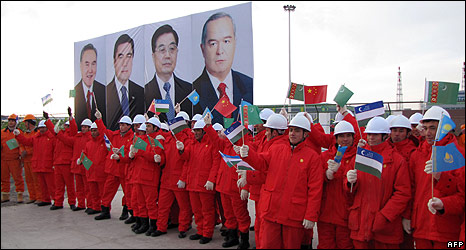
China to Increase Central Asian Gas Imports Through Multiple Pipelines
Publication: Eurasia Daily Monitor Volume: 9 Issue: 152
By:

Beijing proposes to increase the volume of Turkmenistani natural gas supplies to China to 65 billion cubic meters (bcm) per year, more than doubling the present level of deliveries. This implies China is scooping up production increments in Turkmenistan in the years immediately ahead. While enlarging the delivery volumes, Beijing works with Central Asian governments to diversify pipeline routes to China, from a single to multiple pipelines.
On July 25-27, a session of the China-Turkmenistan inter-governmental economic commission held in Beijing mapped out measures to reach the targeted delivery volumes. The session, co-chaired by Deputy Prime Ministers Baymurat Hojamuhammedov (responsible for oil and natural gas) and Wang Qishan, discussed: further field development at the Bagtyarlyk and South Yolotan field projects, led by China’s National Petroleum Corporation (CNPC); raising annual gas deliveries in two steps, from 30 bcm per year to 40 bcm and 65 bcm per year; and expanding the capacity of the Turkmenistan-China pipeline by adding new lines, including a parallel Line C (see below) via Uzbekistan and Kazakhstan to China (Xinhua, July 27; Trend, July 31; TDH [Turkmen government news agency], July 31, August 2).
The transit pipeline, Turkmenistan-Uzbekistan-Kazakhstan-China, measures approximately 1,830 kilometers in length (including 188 kilometers in Turkmenistan, 530 kilometers in Uzbekistan, and 1,115 kilometers in Kazakhstan). It consists of the parallel Lines A and B, with a design capacity of 30 bcm per year in combination, planned to be increased to 40 bcm in 2013. Following the construction start in August 2007, Lines A and B commenced operations officially in December 2009 and October 2010, respectively. But they operate below capacity at this early stage, pending completion of works on Line B in Uzbekistan and Kazakhstan, and installation of full compressor power along the entire dual pipeline.
According to Beijing’s data, the transit pipeline carried 30 bcm of Turkmenistani gas to China from January 2010 to June 30, 2012, and will pump 14 bcm in the second half of 2012 alone. The latter figure implies that the pipeline is well on course to reach the 30 bcm operating capacity in 2013 (Xinhua, July 27). Kazakhstan’s Oil and Gas Ministry corroborates those delivery figures with data on the transit flow through the Kazakhstan section (Trend, August 6).
The section on Turkmenistan’s territory is a joint venture of CNPC with Turkmennebitgaz. In 2006, the two governments contracted for deliveries of 30 bcm of Turkmen gas annually to China for a 30-year period, calculated from 2010 onward. Already in 2010, they agreed to increase the delivery volume to 40 bcm per year. In December 2011, Presidents Hu Jintao and Gurbanguly Berdimuhammedov agreed verbally to expand both the delivery volume and the pipeline’s capacity to 65 bcm per year. Both sides confirmed that agreement in June 2012 during the Shanghai Cooperation Organization’s (SCO) summit in Beijing.
At that summit, President Hu conferred with the presidents of Kazakhstan and Uzbekistan on expanding the capacity of the transit pipeline from Turkmenistan through their territories. The capacity expansion involves additional compressor power on Lines A and B, as well as construction of Line C. Also at the SCO summit, CNPC chairman Jiang Jiemin discussed the planned expansion with those three countries’ government officials (see EDM, June 19).
On Line C, preliminary work started in December 2011. Plans envisage the first gas flow by January 2014, reaching an annual flow rate of 25 bcm by December 2015 (presumably from the 2016 calendar year onward).
China and Uzbekistan founded their project company in 2008 to design, construct and operate the transit pipeline to China on Uzbekistan’s territory. The company, Asia Trans Gas, is a joint venture of CNPC and Uzbekneftegaz. It started construction work in that same year, opened Line A in December 2009 through Uzbekistan, and aims to complete construction of Lines A and B by the end of 2012. In September 2011, the same partner companies signed an agreement to build and operate Line C of the Turkmenistan-China transit pipeline on Uzbekistan’s territory. On the commercial side, Uzbekneftegaz and CNPC signed in 2010 an agreement on deliveries of 10 bcm of gas per year, using the Kazakhstani section of the transit pipeline to China (www.aucconline.com, accessed August 7).
Kazakhstan, with the longest section of the Turkmenistan-China transit pipeline on its territory, is adding a dedicated export pipeline for its own gas exports to China, in growing volumes.
During the June SCO summit (see above), the Chinese President held preliminary talks with the presidents of Tajikistan, Kyrgyzstan and Afghanistan on possible construction of branch-offs from the existing transit pipeline into those three countries, with the same ultimate destination – China. CNPC has offered to conduct technical and economic feasibility studies for a potential Turkmenistan-northern Afghanistan-Tajikistan-China pipeline route, or a possible Kazakhstan-Kyrgyzstan-China route.
On August 2, a session of the China-Kyrgyzstan inter-governmental economic commission held in Beijing resolved to support the construction of a pipeline for Turkmenistani gas to China via Kyrgyzstan. The proposed line would branch off from the Kazakhstani section of the Turkmenistan-China transit pipeline. That line runs through Kazakhstan to China’s border at Horgos, connecting there with the Chinese pipeline grid. The branch-off now proposed would reach China by a detour through Kyrgyzstan’s south. According to Kyrgyzstan’s Economy Minister, Temir Sariyev, the country would be entitled to a lift-off of Turkmenistani gas from the transit pipeline at the existing, discounted price for Turkmenistan’s gas, which China also enjoys. Moreover, direct availability of Turkmenistani gas would end Kyrgyzstan’s now-total dependence on supplies from Uzbekistan, relieving both sides from their chronic disputes on this account. Bishkek also apparently expects such a pipeline to promote overall cohesion between Kyrgyzstan’s north and south (KyrTAg, AKIpress, August 2). The initiative behind this proposal is unequivocally China’s, but Bishkek had been hoping and occasionally pleading for it (RFE/RL, August 15, 2007; Interfax, April 25, 2011).
In contrast to Uzbekistan and Kazakhstan, the three newly-proposed transit countries are desperately short of natural gas resources and infrastructure. China-bound transit pipelines, if built in those three countries, would: boost the total transit capacity for Turkmenistani and other Central Asian gas heading for China; diversify the delivery routes to China for enhanced security of supply, both physically and politically; supply energy-starved Kyrgyzstan, Tajikistan and Afghanistan with agreed lift-off volumes from the gas transit flow; and give Beijing commercial leverage in negotiating bilaterally with each of these additional transit countries, which, lacking natural gas resources, correspondingly lack counter-leverage.
Whether such new routes (if constructed) would divert some of the supplementary volumes envisaged for the main transit pipeline, is too early to tell. Such new routes could absorb volumes from the main transit flow, once this increases beyond 40 bcm per year (i.e., once Line C is built). But those additional routes may also be envisaged to carry future gas volumes from Turkmenistan’s vast resources, once they come on stream. China’s current goal of importing 65 bcm per year from Turkmenistan by 2015-2016 is probably an interim goal, not a final one.




